Distillation Overhead Selection Criteria: How to Size a Condenser
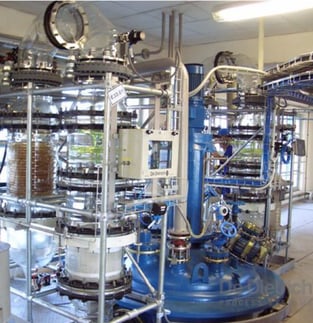 If you have a reactor in your facility, chances are it isn’t just sitting there as a solo piece of equipment. More than likely, it is a part of a system that integrates other components to carry out multiple operations. Many batch applications require the use of distillation overheads to carry out additional process functions, as reaction and distillation are often combined. Basically, what happens here is the materials undergo a chemical reaction to create the desired products and then these products are separated into an end product and a by-product via distillation.
If you have a reactor in your facility, chances are it isn’t just sitting there as a solo piece of equipment. More than likely, it is a part of a system that integrates other components to carry out multiple operations. Many batch applications require the use of distillation overheads to carry out additional process functions, as reaction and distillation are often combined. Basically, what happens here is the materials undergo a chemical reaction to create the desired products and then these products are separated into an end product and a by-product via distillation.
While there are many choices when selecting a reactor, size and material of construction are usually dictated by your batch volume and the characteristics of the solvents/materials involved. It can get more confusing, however, when it comes time to select your overheads. In this post we’ll focus on design options, and how to size a condenser.
First things first though – “overheads” is a rather general term, isn’t it? It’s one that we commonly use at De Dietrich, but it might not be the word that comes to mind for you. Other phrases that can be used interchangeably with overheads includes condensers, rectification columns, distillation equipment, and heat exchangers. The term “batch” is often included to denote that the operation is discontinuous. Throughout this post we’ll use all these expressions, but we wanted you to be aware that they mean virtually the same thing.
Overhead Design Options
There are multiple options available for overhead arrangements, and the one you select is dependent on your process objectives. Vessel overheads are suitable for various processes, including:
- Boiling under reflux
- Distillation
- Hydrodistillation
- Rectification
The following examples are operated at atmospheric pressure or under vacuum. They are mostly for batch operations but can be run in continuous mode.
Standard Arrangement Option 1:
Boiling Under Reflux Distillation with Coil Heat Exchanger
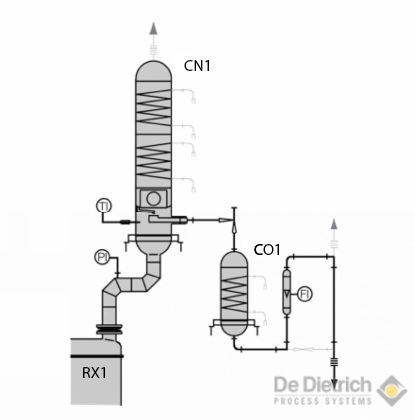
Overhead features: This apparatus includes a coil heat exchanger that enables uprising condensation.
Benefits:
- Reflux has minimal subcooling, maximizing reactor’s vaporization rate.
- coil condenser has low pressure drop
- coil condenser is self baffling, eliminating flat surfaces for CIP
- Angled orientation are available for restricted height installations.
Standard Arrangement Option 2:
Boiling Under Reflux Distillation with Shell & Tube Heat Exchanger
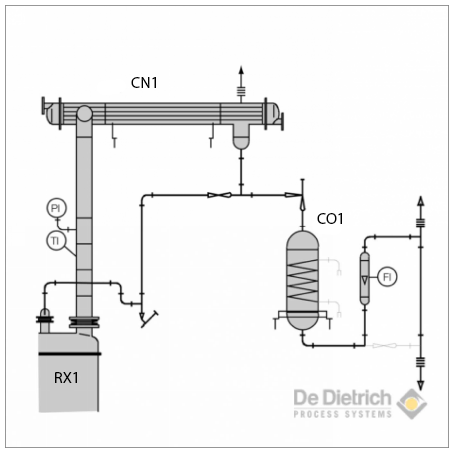
This design is similar in operation and benefits of the coil style condenser, but required for larger reactors / condenser duties. It adds the benefit of lower height requirements.
Standard Arrangement Option 3:
Distillation with Phase Separation
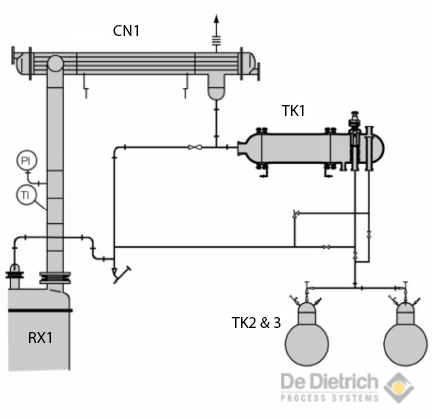
Overhead features: This arrangement is typically used when the distillate forms 2 phases as distillates (e.g. for water removal during esterification, hydrodistillations and heterogenous azeotropes). The phase separator permits the adjustment of the interphase and the separate withdrawal of the light and heavy phase. The light phase and the heavy phase can selectively be guided back into the vessel or withdrawn, depending on your process requirements.
Benefits: Glass separator provides excellent visual confirmation of interface.
Standard Arrangement Option 4:
Vacuum Distillation
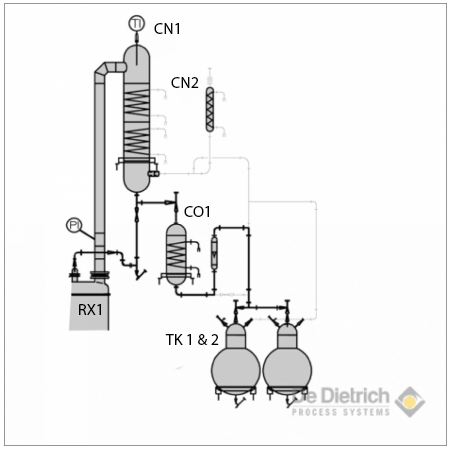
Overhead Features: In this arrangement, the vapors flow down through the condenser to maximize subcooling, to avoid revaporization of distillate. Additional vacuum tubing/piping is provided on receivers to facilitate multiple cuts will under vacuum.
Benefits: Glass coil provides low pressure drop to allow higher vacuum level in reactor.
Standard Arrangement Option 5:
Rectification
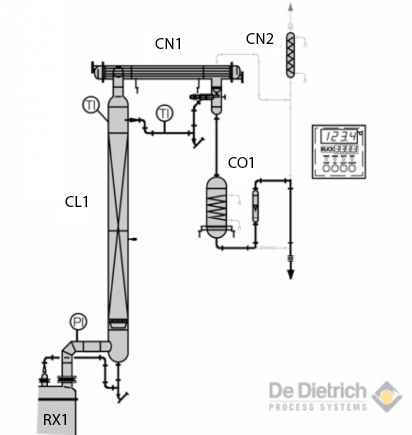
Overhead features: Here a packed column with a reflux divider is used between the condenser and the reactor. This enables volatile substances with closer boiling points to be separated by rectification from each other. The column height and the type of column internals are fixed in accordance with the separation problem and the available height.
Benefits:
- Glass column provides excellent visual confirmation of proper column performance
- Glass surface of column & packing has excellent release characteristics
Condenser Sizing
The selection, layout, and sizing of the condenser for a batch operation is a very detailed procedure when all the parameters are defined. Here we’ll focus on condenser sizing procedures based upon the size of the glass or glass-lined steel reactor. This is a useful tool for initial equipment sizing prior to final process design.
Energy Balance Overview:
In the overall heat balance, we can simplify the heat duty required by the condenser by ignoring the heat loses (reactor should be insulated), and distillate subcooling, which will be performed by a secondary heat exchanger:
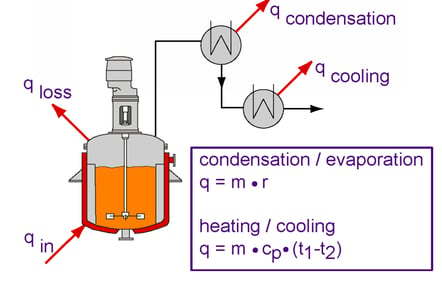
Thus, our condenser duty is equal to our reactor’s heat input:
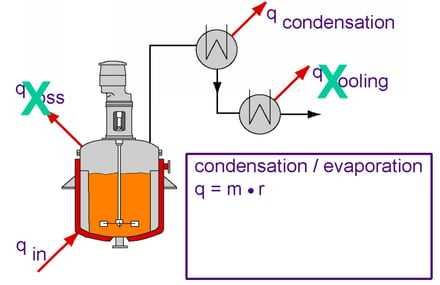
Setting Q rxtr (evaporation only) = Q cond, gives
A jkt x ΔTLM x U rxtr = A cond x ΔTLM cond x U cond,
Solving for A cond = (A jkt x ΔTLM x U rxtr)
(ΔTLM cond x U cond)
We factor out ΔTLM, by assuming the jacket temperature difference will be about ½ of the reactors due to a smaller difference in utilities to bubble point temperatures & rise in coolant thru the condenser.
And, the U values for typical applications of glass/glass-lined steel reactors and condensers are:
- Glass-Lined Steel Reactor - 70 BTU/hr-ft2-F (steam heating)
- Glass Coil - 50 BTU/hr-ft2-F (water cooling/organic vapors)
- Glass Shell & Tube - 70-100 BTU/hr-ft2-F
- SiC Shell & Tube - 160-370 BTU/hr-ft2-F
This provides us with: A cond = A jkt x 2 x (Urxtr/Ucond)
and for:
Glass Coil HX: 2.8 x A rxtr jkt (which we round to 3 x A rxtr jkt)
Glass Shell & Tube HX: 2 to 1.4 (which we round to 1 to 2 x A rxtr jkt)
SiC Shell & Tube HX: 0.9 to 0.4 (which we round to 0.5 to 1.0 x A rxtr jkt)
The following chart is a handy reference to use to when sizing a condenser. It lists the estimation for the maximum evaporation rate based on heat exchanger type, as described above:
|
Heat Exchanger Type |
Factor x Vessel Heating Area (ft2) |
|
Coil type |
1.5-3 |
|
Shell and Tube (glass tubes) |
1-2 |
|
Shell and Tube (SiC tubes) |
0.5-1 |
The low factor applies to atmospheric pressure and a solvent of high boiling point. For vacuum and a low boiling point, the higher factor must be used.
Again, this is a very preliminary sizing to aid in initial scoping. Detailed questionnaires on condenser / heat exchanger sizing are available to further develop your overheads.
The combination of smaller sized glass reactors or large-capacity glass-lined steel reactors with Borosilicate glass distillation overheads provides an advantageous solution for the production of highly refined and highly pure products such as fine chemicals, plant protection agents, vitamins, and pharmaceuticals. And since borosilicate glass is transparent, the process can be visually controlled at any time, improving the safety and reliability of production. De Dietrich also provides this expertise and knowledge in providing overheads in other materials.
De Dietrich offers a variety of standard distillation overhead configurations for borosilicate glass vessels ranging in size from 1.5 gallons (6 L) to 12.5 gallons (50 L). This prepackaged reactor system, known as the Universal Reactor System, comes equipped with the required instrumentation and only needs to be connected to heating a cooling media. For processes that require larger volumes, glass-lined steel reactors are used instead. Additional sizes, designs, and customization are available based on your unique application. Fill out our Reactor Overheads Questionnaire and a De Dietrich representative can contact you with more information about the right overheads solution for your process.
